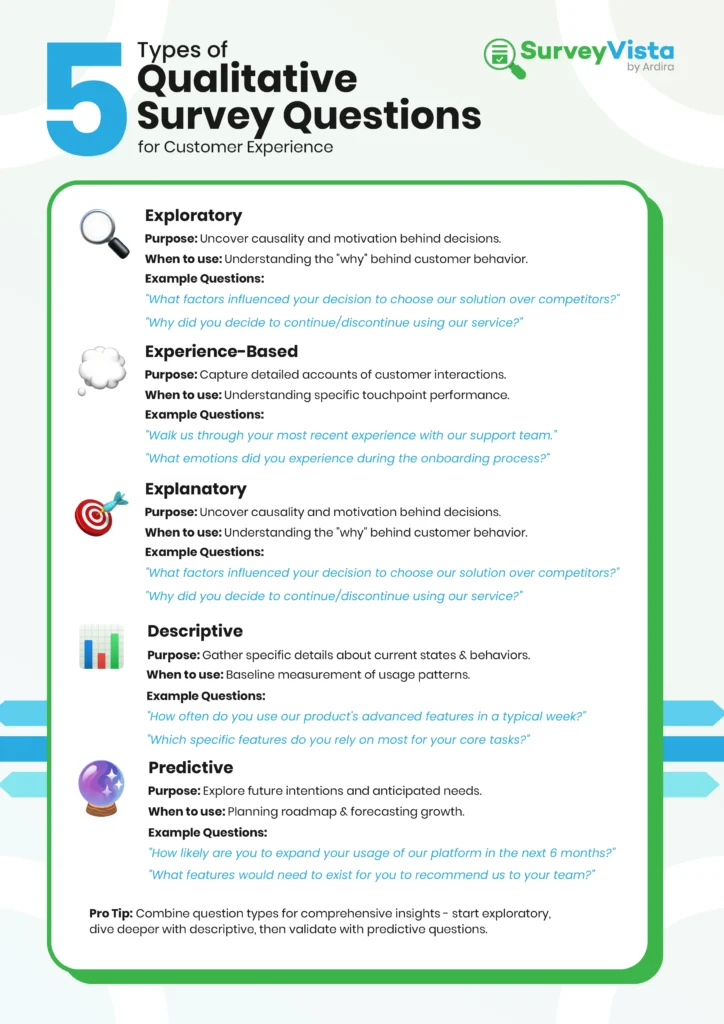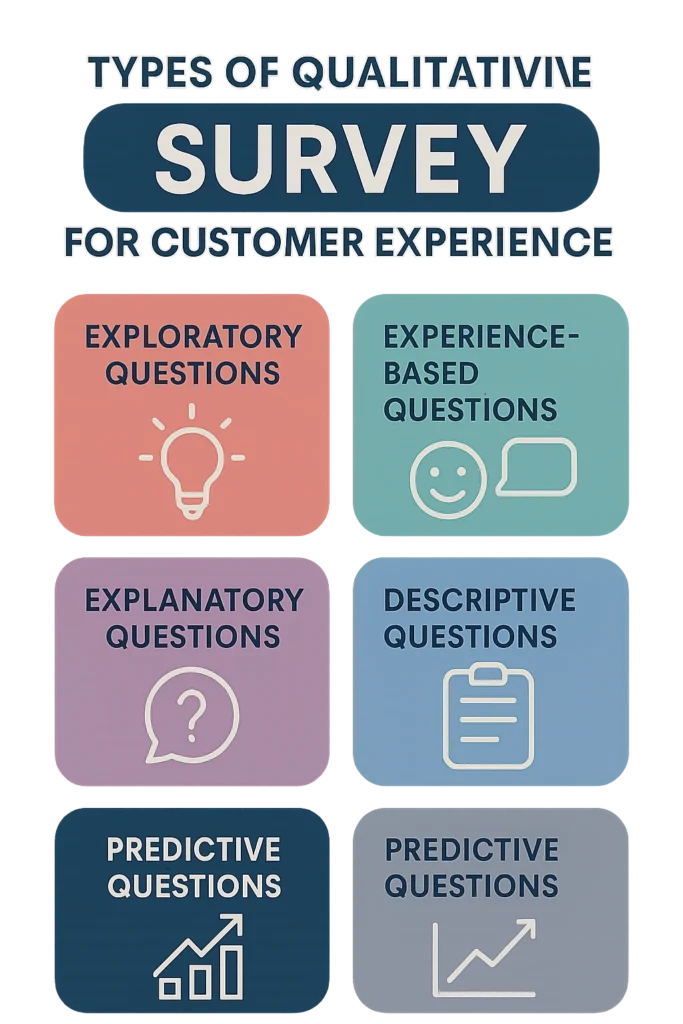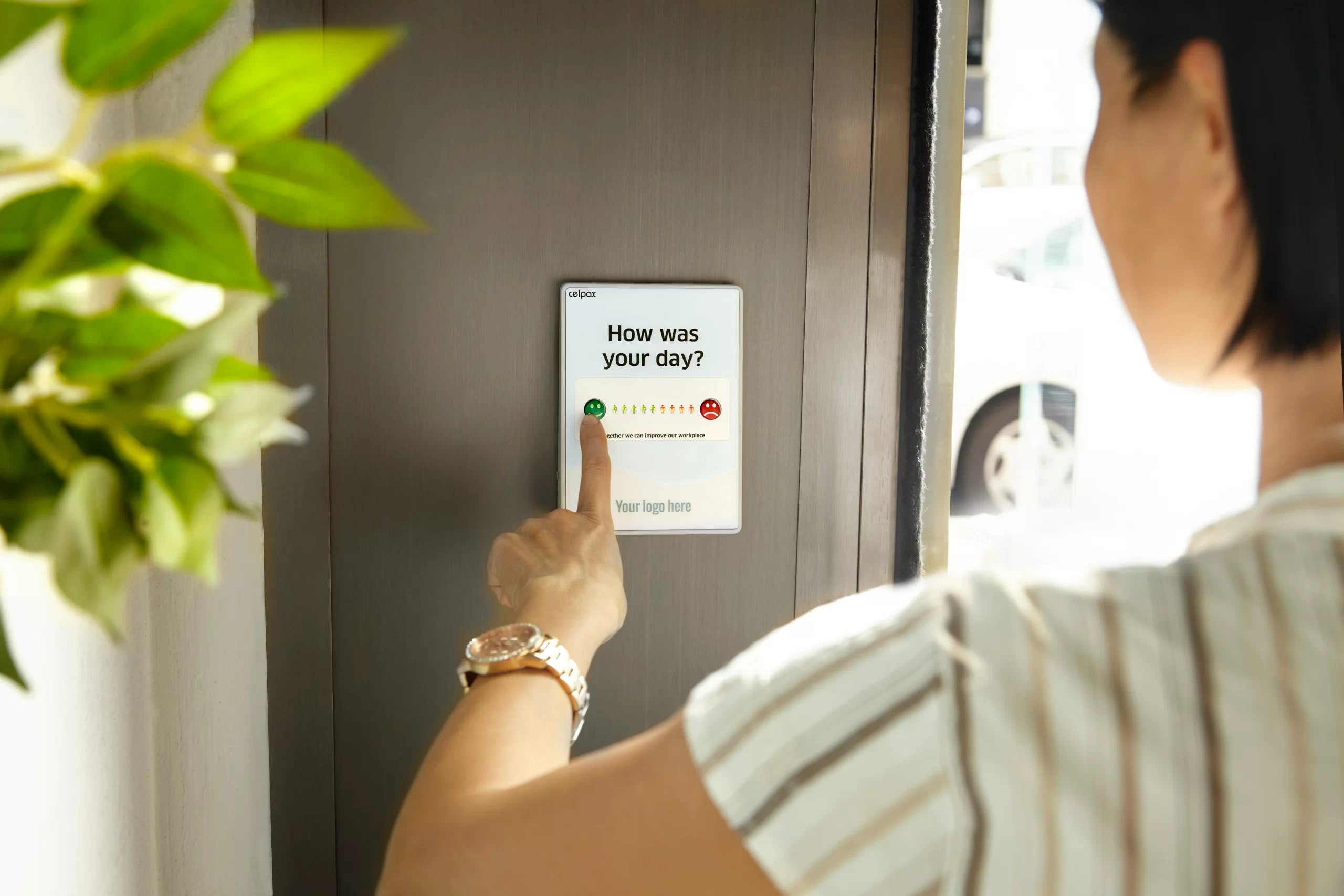Qualitative survey questions form the backbone of meaningful customer feedback. Unlike their quantitative counterparts, these questions unlock the stories, emotions, and motivations behind customer behaviors—insights that numbers alone can’t capture. For customer experience professionals and marketers using SurveyVista’s Salesforce-native platform, mastering qualitative questions transforms ordinary feedback into actionable intelligence that drives growth and retention.
What Are Qualitative Survey Questions?

Qualitative survey questions focus on gathering descriptive, open-ended responses rather than numerical data. They explore the “how” and “why” of customer experiences, providing context and depth to your feedback collection efforts. When integrated with Salesforce through a platform like SurveyVista, these responses become powerful drivers of customer-centric improvements.
Qualitative vs. Quantitative Questions
While quantitative questions measure “how many” or “how much,” qualitative questions reveal the underlying reasons and emotions. For example:
- Quantitative: “On a scale of 1-10, how satisfied are you with our customer service?”
- Qualitative: “What aspects of our customer service experience stood out to you most?”
Both approaches have their place in a comprehensive feedback strategy, but qualitative questions often reveal unexpected insights that quantitative methods miss.
Qualitative questions invite customers to tell their story. They uncover the why, what, and how behind every interaction. Try asking: “Describe your recent experience with our customer support” and watch the insights flow.
These open-ended gems reveal context you’d never capture with checkboxes alone. When you need to understand motivations, frustrations, or unexpected use cases, qualitative questions deliver the depth that drives real change.
Quantitative questions turn feelings into data points. “Rate your satisfaction from 1 to 10” transforms subjective experiences into trackable metrics.
Types of Qualitative Survey Questions for Customer Experience

Exploratory Questions
These questions work best when you’re investigating new territory or seeking fresh perspectives:
- “What challenges do you face when using our product in your daily workflow?”
- “How would you describe your ideal experience with our service?”
Experience-Based Questions
These questions capture detailed accounts of customer interactions:
- “Walk us through your most recent experience with our support team.”
- “What emotions did you experience during the onboarding process?”
Explanatory Questions
These questions help uncover causality and motivation:
- “What factors influenced your decision to choose our solution over competitors?”
- “Why did you decide to continue/discontinue using our service?”
Descriptive Questions
These questions gather specific details about current states and behaviors:
- “How often do you use our product’s advanced features in a typical week?”
- “Which specific features do you rely on most for your core tasks?”
Predictive Questions
These questions explore future intentions and anticipated needs:
- “How likely are you to expand your usage of our platform in the next 6 months?”
- “What features would need to exist for you to recommend us to your team?”
How to Write Good Qualitative Survey Questions
Key Principles for Question Design
- Keep questions open-ended – Avoid yes/no formats that limit response depth
- Maintain neutrality – Remove leading language that might bias responses
- Focus on specificity – Target precise aspects of the customer experience
- Consider context – Align questions with the customer journey stage
Common Pitfalls to Avoid
- Asking double-barreled questions that address multiple issues simultaneously
- Using technical jargon unfamiliar to respondents
- Creating overly broad questions that generate vague responses
- Imposing assumptions that limit response options
Practical Applications in Salesforce Environments
Integrating Qualitative Feedback with Customer Data
SurveyVista’s Salesforce integration allows you to connect qualitative responses directly to customer profiles, creating a comprehensive view of each relationship. This integration enables teams to:
- Track sentiment changes across the customer lifecycle
- Identify patterns in feedback based on customer segments
- Connect qualitative insights with quantitative metrics like NPS or CSAT
Cross-Departmental Benefits
Qualitative survey data collected through SurveyVista benefits multiple teams:
- Marketing teams gain authentic customer language for messaging
- Product teams discover unmet needs and improvement opportunities
- Customer success teams identify at-risk accounts through sentiment analysis
- Executive leadership receives contextual insights for strategic decisions
25 Powerful Qualitative Survey Question Examples
For Product Experience
- “What features of our product do you find most valuable to your work?”
- “How has our product changed the way you accomplish tasks?”
- “What aspects of our product could be improved to better serve your needs?”
- “Describe a situation where our product exceeded your expectations.”
- “What functionality do you wish our product offered?”
For Customer Service Evaluation
- “How would you describe your recent interaction with our support team?”
- “What could our representatives have done differently to improve your experience?”
- “What aspects of our support process worked well for you?”
- “How did our response time affect your overall satisfaction?”
- “What emotions did you experience during your support interaction?”
For Brand Perception
- “What three words would you use to describe our company?”
- “How do you perceive our brand compared to competitors?”
- “What values do you associate with our organization?”
- “How has your perception of our company changed over time?”
- “What would make you more likely to recommend us to colleagues?”
For Implementation and Onboarding
- “What challenges did you face during implementation?”
- “How prepared did you feel after completing onboarding?”
- “What additional resources would have improved your onboarding experience?”
- “How did the implementation process compare to your expectations?”
- “What aspects of getting started were most confusing?”
For Strategic Decision-Making
- “How might changes in your industry affect your use of our solution?”
- “What business problems are you still struggling to solve?”
- “How do you measure the value our solution provides to your organization?”
- “What would cause you to consider alternative solutions?”
- “How does our product fit into your long-term business strategy?”
Analyzing Qualitative Responses in SurveyVista
From Feedback to Action
SurveyVista’s Salesforce-native platform transforms qualitative responses into actionable insights through:
- Sentiment analysis that categorizes emotional tone
- Theme identification that groups similar responses
- Priority scoring that highlights urgent issues
- Trend tracking that monitors changes over time
Closing the Feedback Loop
The true value of qualitative questions emerges when insights drive action:
- Collect feedback through targeted qualitative questions
- Analyze responses within SurveyVista’s Salesforce environment
- Distribute insights to relevant departments
- Implement changes based on customer input
- Communicate improvements back to customers
- Measure impact through follow-up surveys
Building a Customer-Centric Organization with Qualitative Insights
Qualitative survey questions provide the context and depth needed to truly understand your customers. When integrated with Salesforce through SurveyVista, these insights become a powerful engine for customer-centric growth. By mastering the art of asking meaningful questions, you’ll uncover the stories behind the numbers and transform feedback into lasting improvements that drive retention and loyalty.
Ready to enhance your qualitative feedback strategy? SurveyVista’s Salesforce-native platform makes it easy to collect, analyze, and act on customer insights across every touchpoint. Contact us today to learn how our solution can help your organization become truly customer-centric.
Frequently Asked Questions
How do qualitative survey questions differ from quantitative questions?
Qualitative questions gather descriptive, open-ended responses exploring the “how” and “why” behind customer experiences, while quantitative questions collect numerical data measuring “how many” or “how much.” Qualitative questions reveal stories and emotions that numbers alone can’t capture.
How many qualitative questions should I include in my survey?
Include 3-5 qualitative questions in a typical survey to prevent respondent fatigue. For in-depth research, you might include more, but always balance the need for rich insights with respect for your respondents’ time and attention span.
How can I analyze qualitative survey responses efficiently?
SurveyVista’s Salesforce-native platform offers sentiment analysis, theme identification, and trend tracking tools that transform open-ended responses into actionable insights. This automation helps categorize feedback and identify patterns without manual coding of every response.
Can qualitative survey data integrate with my existing Salesforce data?
Yes, SurveyVista’s platform connects qualitative responses directly to customer profiles in Salesforce, creating a comprehensive view of each relationship. This integration enables tracking sentiment changes across the customer lifecycle and identifying patterns based on customer segments.
What’s the best way to follow up on qualitative feedback?
After analyzing qualitative feedback, distribute insights to relevant departments, implement changes based on customer input, communicate improvements back to customers, and measure impact through follow-up surveys. This closes the feedback loop and demonstrates that you value customer input.
More Like This

Rajesh Unadkat 
Founder and CEO
Rajesh is the visionary leader at the helm of SurveyVista. With a profound vision for the transformative potential of survey solutions, he founded the company in 2020. Rajesh's unwavering commitment to harnessing the power of data-driven insights has led to SurveyVista's rapid evolution as an industry leader.
Connect with Rajesh on LinkedIn to stay updated on the latest insights into the world of survey solutions for customer and employee experience management.



